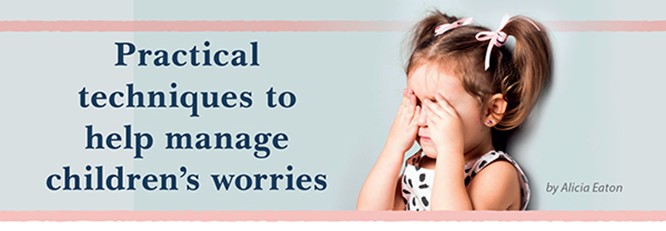Practical techniques to help manage children’s worries

Guest post by Alicia Eaton
Anxiety and worries are on the increase in young children and it’s reported that even those as young as 4 years old are starting to display signs of panic attacks. By using the following simple strategies from an early age parents can help their children manage feelings of anxiety and ensure they have tools to call on whenever they are worried or anxious.
1. And breathe… When we’re feeling anxious, our breathing becomes shallower and this can create the sensation that it’s a struggle to breathe. A common misconception is that the solution is to ‘take a nice deep breath’. In fact, doing the opposite – blowing the excess air out – helps to calm things down. Practice this with your children in advance of a problem to ensure they know what to do should feelings of panic strike.
Toys and games can help children to do this and some examples are: • a hand-held windmill toy with sails • some bubble mixture to blow through a wand • blowing balloons • blowing bubbles in a drink through a straw • blow football • blow a feather from one side of the table to another • You can also ask your child to scrunch up their hand and simply imagine that they’re blowing up a balloon or paper bag – long, slow breathing out is what’s required.
2. Let’s pretend… Discuss situations such as a doctor’s visit in advance, rather than taking your child by surprise. From the age of two years, you can start using dolls, teddy bears and story-telling to help explain what the visit will entail. Take turns at playing ‘Doctors’ by giving a favourite teddy an injection or a dental examination. Older children might have a favourite TV character or super-hero and you could ask them to think about what they think this character would do if faced with the same challenging situation that they’re in at the moment.
3. Mindfulness made easy... We often hear that living in the moment or ‘Mindfulness’ can reduce stress and greatly enhance the quality of our lives – it’s an excellent way of reducing your child’s feelings of anxiety. Young children are rarely still and quiet nowadays and it’s becoming harder for them to keep a lid on their emotions and think before they act. Achieving a state of complete silence, peace and calm is difficult for most children but a Mindfulness Jar is a useful way of teaching them how to be still:
The mindfulness jar
1. Ask your child to fill an empty jar (the larger the better) almost to the brim with water and then tip in some glitter and close the lid tightly shut.
2. Vigorously shake the jar to spin the glitter pieces around and then sit calmly to watch the glitter pieces swirl around and eventually settle.
3. Count to see how long it takes – or use a stopwatch or clock and record the length of time in a notebook. Keeping a record will make it more interesting – next time will the pieces take longer to come to a complete standstill, or will it be quicker? This activity can also be used as a time-out exercise – so much better than the use of a ‘naughty step’!
Alicia Eaton is a children’s emotional well-being specialist based in Harley Street and author of First Aid for your Child’s Mind available on Amazon priced £12.99.
To find out more go to: www.aliciaeaton.co.uk